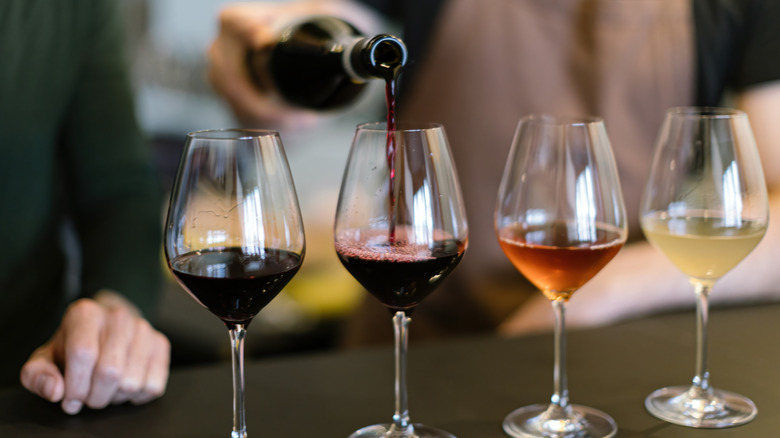The 3 Wine Aroma Classifications You Should Be Familiar With
Many would agree that wine is more than a beverage — it's an experience. When you open a bottle of wine, you should be prepared to invest in the journey of that bottle. From the moment of uncorking to the last drop in the bottle, every wine is as unique and complex as it is ephemeral. To better honor the wine and create a full-spectrum experience for yourself, it helps to know that much of what makes a wine distinct is centered on its aroma. Three classifications of aroma make up a wine: Primary, secondary, and tertiary, each with its place in the composition of a wine.
Not to be confused with the odor, the aroma is enjoyed by both the mouth and the nose simultaneously. In the case of wine, it starts with the primary aroma that comes from the grape itself; this is where fruits and greenery occur on the nose. Then comes the secondary aroma, which results from fermentation and vinification; the secondary aroma typically presents as yeasty brioche or buttery, milky notes. Lastly, the tertiary aroma displays the depth of a wine — loamy, smokey, leathery notes are present here.
Primary and secondary aromas in wines
Primary aroma is as it sounds — this is the first impression. The initial perception of a wine exists directly on the nose. Have you ever opened a bottle of spritzy white and smelled grapefruit or river rocks? These are primary aromas. The grapes used to make the wine contain terpenes — found in all kinds of plant and organic matter — which inform the aroma with bright, fruity, or floral notes. Grape varietals containing the terpene geraniol will often smell of roses and other light florals, whereas varietals containing limonene and citral will provide orange peel or grapefruit on the nose. Spicier terpenes like rotundone come across as black pepper — think "peppery" wines like Syrah or Gamay.
Secondary aroma can tell you about the life of the wine; it shows the depth of some wines, depending on the maturity of the bottle. The secondary aroma showcases the conversion of sugar into alcohol, as well as the environment in which fermentation takes place. If a wine is aged in new oak barrels, it may come across with strong vanilla aromas. If a full-bodied wine has had time in the cellar, it may contain tobacco or tannic qualities. Some secondary aromas may read like bread or yeast as well, which is why people often refer to champagne aroma as brioche.
Tertiary, wine's final aroma
Last, but not least, the tertiary aroma (or "bouquet") will give you a sense of the wine's age. It can come across as deep and loamy — and if you're dealing with a particularly rustic red, you may find yourself swirling a glass of effluvia, blowing off the fumes of barnyard. This tertiary stage is affected by the tannic nature of the wine; it can develop into notes of oil or even petrol in some wines. Think of this as the darkest parts of a wine, where all its aged glory shines through — something to consider when pairing your wine with food.
When you're enjoying wine, take your time with it. Allow all of your empirical apparatus to experience the wine. It can be as simple as closing your eyes or taking the time to smell the wine between each sip. Wine that has just been opened can transform entirely with a little time and exposure to oxygen. The next time you uncork a bottle, see if you can identify every stage of its aroma. A study conducted by Rockefeller University in 2014 determined humans can detect up to 1 trillion different smells, and the best way to develop your sense of smell is to use it — so think about drinking wine as a (deeply enjoyable) gym for your olfactory system.


